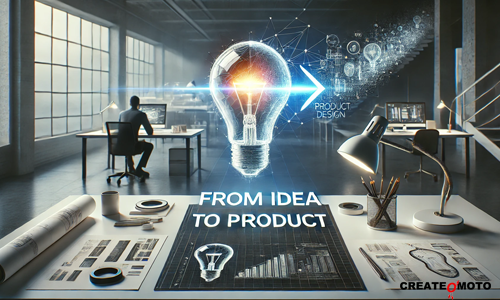Bringing a product from a simple idea to the marketplace is an exciting yet challenging journey. Whether you’re an experienced entrepreneur or just starting out, understanding the product design process is essential. This guide will take you through each step, highlighting the importance of persistence and hard work. Remember, while the path may not always be easy, the rewards of dedication and perseverance are well worth it.
Step 1: Ideation – Igniting Creativity
The first phase in the product design process is ideation. This is where your creativity takes center stage, and you begin to generate ideas that address real-world problems or fulfill unmet needs.
What to Do:
- Brainstorming: Gather a diverse team to explore various ideas. Techniques like mind mapping or “how might we” questions can help spark creativity.
- Market Research: Dive deep into existing solutions. Conduct surveys, interviews, and analyze competitors to understand what’s missing in the market. This foundational knowledge is vital for shaping your ideas.

Step 2: Concept Development – Refining Your Ideas
Once you’ve generated a list of potential ideas, it’s time to narrow them down and develop them into viable concepts.
What to Do:
- Sketching and Prototyping: Create rough sketches or low-fidelity prototypes to visualize your concepts. Tools like Adobe XD or Sketch can assist in this process.
- User Feedback: Present your concepts to potential users and gather their feedback. Their insights will help you refine your ideas further, ensuring they align with user needs.
Step 3: Design Refinement – Polishing Your Concept
After gathering user feedback, it’s time to enhance your design. This stage is all about fine-tuning and preparing for the next steps.
What to Do:
- High-Fidelity Prototyping: Develop more detailed prototypes that resemble the final product. Tools like Figma or InVision are excellent for creating interactive designs.
- Technical Specifications: Document all technical details, including materials, dimensions, and manufacturing processes. Clear documentation helps streamline production later on.
Step 4: Testing – Validating Your Product
Testing is a critical step to ensure that your product meets expectations and functions as intended.
What to Do:
- Usability Testing: Conduct tests with real users to identify any usability issues. Observing how users interact with your prototype can provide valuable insights.
- Technical Testing: Assess the product’s functionality and durability. This can include stress testing to ensure it can withstand real-world use.

Step 5: Final Design – Solidifying Your Product
With feedback and testing complete, it’s time to finalize your design. This phase solidifies all the decisions made in the earlier steps.
What to Do:
- Final Adjustments: Make any necessary changes based on testing results. Be open to further iterations to perfect your product.
- Production Planning: Collaborate with manufacturers to prepare for production. Ensure that all specifications are clear and feasible for manufacturing.
Step 6: Launch Preparation – Getting Ready to Go Live
With a finalized design, it’s time to gear up for the product launch. This is a crucial step that requires thorough planning and strategy.
What to Do:
- Marketing Strategy: Develop a comprehensive marketing plan that encompasses branding, messaging, and promotional tactics. Utilize social media, content marketing, and PR to create excitement.
- Distribution Channels: Determine how you will sell your product—through e-commerce platforms, retail partnerships, or direct sales.
Step 7: Launch – The Moment of Truth
The launch is where all your hard work pays off. It’s the moment your product becomes available to the public.
What to Do:
- Launch Event: Consider hosting a launch event to generate buzz. Engage influencers and the media for additional coverage.
- Monitor Feedback: After launching, keep an eye on customer feedback and sales data. This real-time information will help you identify any immediate issues or opportunities for improvement.
Step 8: Post-Launch Evaluation – Reflecting and Improving
The final phase involves evaluating your product’s performance in the market. This is crucial for understanding your product’s success and planning future iterations.
What to Do:
- Sales Analysis: Review your sales figures and assess market performance.
- Ongoing Feedback: Continue to collect feedback from users. Their insights can guide future improvements or new features.
Remember, the product design process is ongoing. Each stage offers opportunities for learning and growth. While it can be challenging, your dedication and hard work will ultimately lead to success. For more insights into the product design journey, check out these helpful resources:
- Createomoto: The Essential Guide to Product Design
- Future.com: Design Thinking
- Product Launch Authority
By embracing this structured approach and staying committed to your vision, you can transform innovative ideas into market-ready products that truly resonate with users. Your journey might be tough, but remember: the rewards of persistence are invaluable!



0 Comments